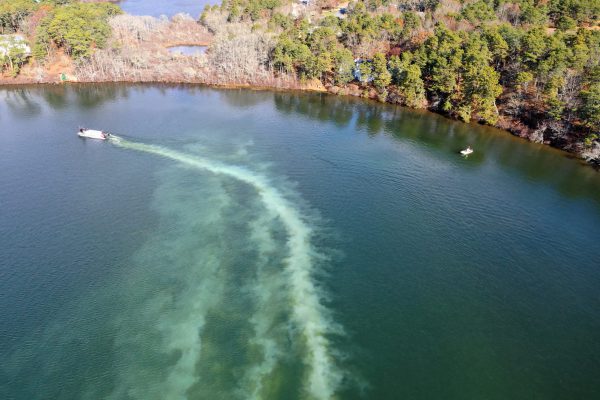Control Nutrient Levels and Improve Lake & Pond Health with All-Natural Alum
Control Nutrient Levels and Improve Lake & Pond Health with All-Natural Alum
When lakes and ponds exhibit problems like algae, aquatic weeds, bad odors, cloudiness, or muck development, it can prevent us from benefiting from the connection with nature that our waterbodies provide. Aquatic experts use a variety of techniques to diagnose the underlying issue. One of the most important tools is water quality testing. By analyzing water samples in a professional laboratory, scientists can identify the chemical imbalances that are preventing you from enjoying your waterbody to the fullest. Once data is collected, experts will implement tailored management solutions to restore the balance and beauty of the ecosystem. One natural and highly effective solution is Alum.
 Utilizing Alum to Restore Water Quality
Utilizing Alum to Restore Water QualityAlum has been a long-standing tool in our toolbox of lake and pond management solutions—and is a particular favorite of professionals who strive to use only sustainable maintenance practices. Alum (also known as Aluminum Sulfate) is used in a wide array of industries and applications such as drinking water management and wastewater treatments. In the lake and pond management industry, Alum is used to reset the chemical balance of aquatic environments to improve water quality. When water quality is enhanced, it creates an environment that is less hospitable to algae, nuisance weeds, and toxic cyanobacteria.
 Perform Water Quality Tests
Perform Water Quality TestsThere is no one-size-fits-all approach to lake and pond management. This means that Alum may not be the right solution for each and every waterbody. Water quality tests help us understand the problems occurring under the surface and make this decision. Most often, Alum is deployed when water quality tests reveal unusually high levels of nutrients like Phosphorus, which is typically the root cause of undesirable organic growth.
How Alum Reduces Nutrients in the Water
Alum is applied to lakes and ponds as a white, powdery substance. As the Alum mixes into the water column, it binds with free-reactive nutrients, creating a cloudy trail behind the boat or a specially-designed application barge. After a short period of time, the particles sink to the bottom where they will remain inactive. Alum is considered very safe when applied by a professional and provides fast-acting results that can last for years. Almost immediately after an application is complete, the water column will become more clear. Over the course of days and weeks, the water quality improves.
Prevent Phosphorus Loading with Proactive Solutions
Once the waterbody is restored to more balanced conditions, it’s important to prevent future nutrient loading by addressing the external sources of Phosphorus. Trash, pet waste, fertilizers, motor oil, sewage, and yard waste are often to blame. They can flow into lakes and ponds during rainstorms. Rainfall and weather events can also damage the shoreline, causing nutrient-rich soil and plant matter to crumble into the water. Stakeholders can slow this problem by establishing a robust vegetative buffer around the shoreline. Professionals recommend using native plants that grow approximately 18 inches high and develop complex root systems to naturally hold soil in place. If shorelines have sustained significant damage over the years, it may be necessary to completely rebuild them using bioengineered mesh technology that can be seeded with the grass and buffer plants following installation.
 Alternative Nutrient Remediation Solutions
Alternative Nutrient Remediation SolutionsAlum is not the only natural substance that removes nutrients in the water column. Solutions like Phoslock and EuroSORB work similarly to target Phosphorus.
Phoslock is a lanthanum-modified clay that binds with excess phosphorus, chemically changing its composition so that they can no longer support weeds and algae. EutroSORB, on the other hand, is a filtration technology that captures nutrients in the water column. It is particularly effective in waterbodies with significant movement and mixing, such as stormwater ponds, streams, and canals. Once the filter is fully saturated with phosphorus, it is pulled from the water for disposal. In some cases, experts may also choose to use an aqueous form of EutroSORB that can be poured or sprayed on the surface, or applied via subsurface injection.
 Determining The Best Solution for Your Lake or Pond
Determining The Best Solution for Your Lake or PondYour lake and pond management professional may consider a number of factors when choosing which of these three nutrient remediation products to implement. These may include your waterbody’s size, location, use, pH, dissolved oxygen concentration, muck level, and degree of water movement.
The well-being of our aquatic environments reflects our own. Science shows that humans are happier, healthier, and more relaxed when spending time around beautiful water. Nutrients are the building blocks that help create these amazing ecosystems that delight us, but it’s necessary to maintain them at balanced levels as nature intended. Alum is one of many eco-friendly tools employed through an annual maintenance program. Like most solutions, it is most effective when used proactively. Click to learn more about the benefits of Alum and the important role it plays in a year-round management plan.
Discover the Power of Nutrient Remediation
Discover more from SFPMA
Subscribe to get the latest posts sent to your email.



